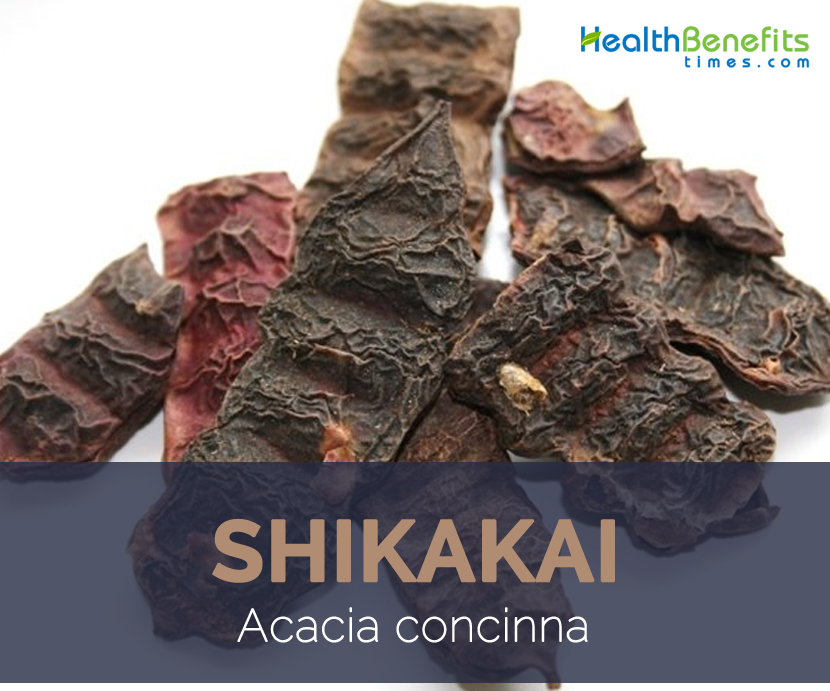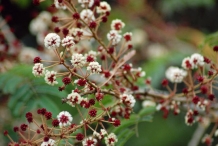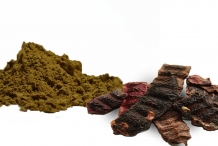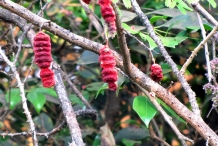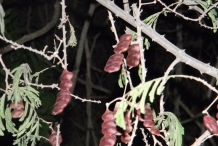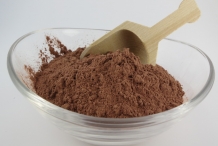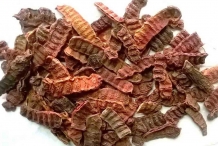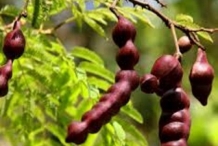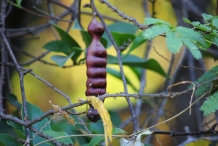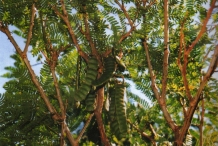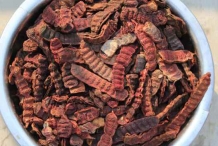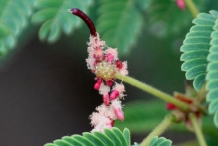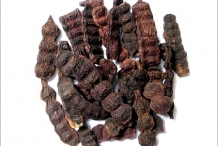The leaves, barks and fruit pods of shikakai are dried, powdered and made into a paste at home to apply on hair. Regular use of shikakai will strengthen your hair strands and reduce hair fall. It also helps to get rid of dandruff and other hair and scalp problems. Besides, shikakai is used in many shampoos and hair medicines for its hair strengthening and conditioning properties.
Plant
Shikakai is a climbing, most well-known for the natural shampoo derived from its fruit. Thorny branches have brown smooth stripes – thorns are short, broad-based, flattened. Leaves are with caducous stipules not thorn-like. Leaf stalks are 1-1.5 cm long with a prominent gland about the middle. Leaves are double-pinnate, with 5-7 pairs of pinnae, the primary rachis being thorny, velvety. Each pinnae has 12-18 pairs of leaflets, which are oblong-lance shaped, 3-10 mm long, pointed, obliquely rounded at base. Inflorescence is a cluster of 2 or 3 stalked rounded flower-heads in axils of upper reduced leaves, appearing paniculate. Stalk carrying the cluster is 1-2.5 cm long, velvety. Flower-heads about 1 cm in diameter when mature. Flowers are pink, without or with reduced subtending bracts. Pods are thick, somewhat flattened, stalked, 8 cm long, 1.5-1.8 cm wide.
Health Benefits of Shikakai
Natural herbs are considered best to use in hair care. One such herb that is widely used and gives extremely amazing result for hair is Shikakai. Shikakai has been used for skin and hair care from ancient times and its benefits are mentioned in Ayurveda. Basically Shikakai fruit pods are used that contain tiny seeds that we throw away. Here are the top benefits and uses for Shikakai pod/powder
1. Strengthens Hair
Coarse and dry hair can make you feel conscious and uncomfortable about letting your hair down. But tying your hair up and keeping it out of the way just compounds your hair woes by breaking and splitting more (due to the pressure and tension from your scrunchies and bands). Shikakai is known to soften and smoothen your hair naturally, by releasing essential oils and vitamins that are key to hair growth. It promotes hair growth and keeps your hair looking soft and shiny so that you can let your hair down now, anytime!
2. Thickens Hair and reduces Hair Loss
Hair loss can lead to stress, which only leads to more hair loss. Using Shikakai for hair loss can significantly help you regain your hair’s lustrous thickness and length. Packed with essential nutrients, Shikakai keeps your hair healthy, prevents breakage and brittleness, both of which are the most common reasons for thinning hair.
3. Fights Dandruff
Shikakai is a great solution to dandruff worries, with its antifungal, antibacterial and nutritional properties. It can be used to treat your scalp, and get rid of your pesky dandruff woes without any side effects. Say goodbye to those embarrassing white flakes on your clothes and hair with the regular and correct use of this incredible herbal remedy!
4. Removes hair lice
Hair lice are one of the embarrassing and pressing problems. Not only do they cause uncontrollable itchiness and scalp discomfort, but they can also cause clumsiness. Because of how rapidly hair lice can spread from person to person, they can quickly turn into a lingering problem with seemingly no solution.
Fortunately, Shikakai offers remedy against hair lice too! Its low pH value along with its antifungal and antibacterial properties can stall the growth of hair lice.
5. Prevents a dry scalp
Shikakai works its magic on a dry scalp by acting as a natural cleanser without washing away essential oils.
6. Adds shine and softness
The natural ingredients of shikakai make your hair softer and add a beautiful shine to it.
7. Heals minor wounds
Owing to its medicinal properties, Shikakai can also come in handy in the case of minor cuts and bruises on your scalp. Shampoos and other lotions can cause pains on the sensitive skin of your scalp, but ground roasted Shikakai paste can offer much relief in such cases!
8. Soothes your head
Shikakai is a key ingredient in making soothing hair packs. Usually composed of Shikakai, amla, yogurt and soap nut, these cooling packs can be of sound relief particularly during hot weather, a nagging headache, or simply for a relaxing experience on a lazy day.
9. Prevents Gray Hair
Aging can be a rather depressing process. Wrinkles, spots, and gray hair appear all too quickly, leaving you looking tired and worn. Retain your youthful charm with naturally thick black hair, by including Shikakai in your regular hair care routine! Using a hair pack made of Shikakai, soap nut and other herbal ingredients like amla can slow down and prevent the process of hair graying, letting your locks keep you looking fresh and young!
Before applying hair dye, (even natural hair dye), hair should be washed with Shikakai. This helps in letting the dye soak better and stay on longer.
10. Gently detangles hair
Shikakai is also great for getting rid of frustrating tangles! Simply run your fingers through your locks while rinsing out the Shikakai paste, and feel the difference for yourself.
11. Treating Scabies
Shikakai is used as antiseptic wash for scabies. To make the wash, first soak turmeric in hot water and rub it into a paste. Take a long piece of shikakai and burn it directly in the fire, till it turns dark. Wait for it cool and grind it into a fine powder. Mix both ground turmeric paste and ground shikakai powder with boiled water. Strain and use as an antiseptic wash on the affected area. Both shikakai and turmeric have an anti-fungal, anti-microbial and anti-bacterial property that makes this an effective wash for scabies. Please consult a doctor, if the condition is very, very severe.
12. Treat spots
Take half a teaspoon of shikakai powder and mix it with a tablespoon each of cream, almond powder and turmeric. Add two tablespoons of honey and use it as a body scrub. This mixture helps in eliminating dead cells and gives your skin a natural glow.
13. For Cuts & Wounds in the Scalp
For small wounds on the scalp, first burn a small piece of shikakai in direct fire. Make sure to burn a long piece, else you will hurt your hand when it burns. Better still burn it using a tong, cool and powder it finely in a mortar and pestle. Grind a small piece of turmeric, fresh neem leaves and the ground shikakai powder to a smooth paste. Grind it using boiled water and apply on the scalp, wait for 10 minutes before washing it off. This remedy is only for minor cuts and wounds on the scalp.
14. Absorbs dyes effectively
Shikakai is a great absorber for dye in the hair and so those who color their hair on a regular basis should consider using it on their hair before they apply the dye. The application of shikakai ensures that your hair absorbs the color in a better and more effective manner.
15. It is cheaper and better
Shikakai is a much cheaper and more natural alternative to chemical-laden shampoos.
Other Traditional benefits of shikakai
- The leaves of shikakai have acidic taste and are used in making chutneys.
- Pods of Shikakai can be soaked in water and then used to clean the skin. Regular use of this remedy will leave your skin looking healthier and younger. It also helps in fighting the signs of ageing by keeping away wrinkles, fine line and dark spots.
- Bark of shikakai contains saponin that has spermicidal activity and hormonal effects, which makes it useful for contraceptive purposes.
- Decoction of shikakai and reetha in water is useful in washing delicate clothes such as silk, cashmere and pure cotton without causing any damage to them. It also helps in removing stains from the clothes.
- Shikakai is effective in treating minor scalp wounds like cuts or bruises. Its mild action along with antibacterial property can aid recovery. Make paste of roasted shikakai powder, neem leaves and turmeric. Apply this paste to scalp wound.
- Shikakai is traditionally used for treating scabies. Above paste made from shikakai, neem and turmeric can be used as antiseptic wash over scabies.
- Extract of leaves of Shikakai are traditionally used in treating malarial fever
- Extracts of shikakai pods and leaves with their phytochemical profile are used as larvicidal and mosquito repellant.
- It is also used in the treatment of Black fever or the fever that occurs during the time of malaria.
- It helps in making the mouth fresh as it is used to remove bad smell. It also cures various diseases of the throat like pain, infections, ulcers or boils in the gums.
- Shikakai also aids in preventing Tooth Degradation and helps in preventing the formation of plaque in the mouth of human beings.
- It reduces the chances or makes the circumstances healthy and helps in preventing the chances of occurrence of diabetes.
- It also lowers down the body cholesterol and even controls the blood sugar levels from becoming too high or even too low.
- It also helps in curing several stomach disorders like constipation and also improves the flow of excreta or urine out from the body.
- It is an effective ingredient in the contraceptives that can also be used in controlling unwanted births diagnosed at earlier stages.
- Shikakai can be effectively used as a treatment for preventing the age spots by adding it to any naturally grown fruit and then applied on the skin or face properly.
- Shikakai, when mixed with lukewarm water can be used to treat various gum diseases.
- Pods appearing in the fruits of the Shikakai plant or tree can be very useful and can be effectively used in curing the disease known as leprosy, by applying it to the affected wounds.
- It even has benefits as it can be very useful in the treatment of a death causing disease known as jaundice and helps in smoothening of the frizzy and very dull hair.
- It is well known for its characteristic of rejuvenation. It even helps in controlling the growth of various glands like the sweat glands and oil causing pigments that are present in our head or in the hair
How to make shikakai shampoo
- Soak a few dried shikakai pods, little reetha and dried amla overnight.
- Boil the water the next morning until the pods soften.
- Cool, mash and strain the liquid, and use it as your shampoo.
- Remember it will not lather as much as a readymade shampoo, but it does the job better.
- You can also boil dried shikakai or shikakai powder, neem leaves, fenugreek powder and some dried amla in a cup of water for 15-20 minutes.
- Cool, mash and strain the liquid.
- Use the water as a natural shampoo.
How to make shikakai oil
- Add one tablespoon shikakai powder to half a cup basil / avocado / coconut oil.
- Put the mixture in a container and let it sit for a few weeks.
- Keep shaking it occasionally. Use the oil in your hair 2-3 times a week and shampoo well.
How to make shikakai hair pack
- Blend of shikakai and yogurt is excellent for your hair.
- Massage in the blend and wash it off after 15-20 minutes.
- Do this every alternate day and see results within a week.
- Add half a cup shikakai and one cup amla powder to a cup of lukewarm water.
- Let this sit for 1-2 hours.
- Apply the paste to your hair and wash it off after 30 minutes.
- This is an excellent remedy for dry and dandruff affected hair.
Shikakai powder for hair growth
Just like the shampoo, making a hair pack is also equally simple. For the hair pack, you need to boil dried shikakai or shikakai powder, fenugreek powder, neem leaves and some dried amla in a cup of water for about 15 minutes. Then let the mixture cool after which you need to mash the contents with your hands. Strain the water and use it to massage the scalp and hair. Leave it on for half an hour and then rinse off with lukewarm water. Shikakai hair packs are very effective in getting rid of dandruff as well as other scalp related problems.
Shikakai hair oil for hair growth
Using shikakai oil is good way of treating your hair. There are two ways of making shikakai oil. One can boil shikakai powder in coconut oil for 10-15 minutes on small flame. Allow the oil to cool before you stain the oil and store oil for future use.
Alternately take 2 table spoon of shikakai powder to a cup of olive oil or avocado oil. Mix well and allow the mixture remain for 3-4 weeks with occasional shaking. This shikakai infused oil can be used as hair nourishing oil. Shikakai oil can be applied to skin as well. So enjoy shikakai oil benefits!
Shikakai hair soap
Shikakai soap or shikakai shampoo bar are low cost hair treatment solutions promoted in some parts of India. These herbal hair wash soap contain shikakai extracts other with other herbs. Amla, Reetha Shikakai Hair Wash soap is a popular combination. Other combinations include Shikakai, Bhringaraj and Brahmi. You may want to give try shikakai soap for hair.
Shikakai Body Wash
You have seen how to use shikakai powder for hair wash. In some places in south India, rice water along with shikakai powder is also used as body wash. Rice is cooked in excess water. Once rice is cooked, this excess water is removed. It is called rice kanji. Rice kanji is mixed with shikakai powder and some aromatic essential oil and can be used as whole body wash.
Shikakai for hair wash
To make shikakai hair wash, boil 1-2 tbsp of shikakai powder or pods in 2 cups of water, till you are left with shikakai paste. Add some more water and honey. Use this shikakai water as hair rinse. Apply to wet hair and massage scalp.
Shikakai Powder Hair Pack
Simply mix some shikakai powder with fresh yogurt and apply to your hair and scalp. Let it remain for 20-30 minutes before you wash with cold water. Regular use can help get good looking stronger and healthier hair.
Culinary Uses
- Acid-flavored young leaves can be used as a substitute for tamarinds in chutneys.
- They are also added to soups to make them hot and sour.
- They can be curried with salted fish and coconut milk.
- Flowers – cooked and eaten as a vegetable.
- Acid fruit are used in Philippine cooking to give a sour flavor.
- Seeds are edible after roasting.
- Young shoots are used to make pickles or cooked as a vegetable.
- It also adds a different flavor of taste to food and can be effectively used to make chutneys and jams.
Other Facts
- Seedpods are widely used as a soap substitute in India.
- Bark is a source of tannins.
- Pods are widely used in India as a detergent for washing silks and woolen goods, and are also very commonly used for washing the hair.
- They are very effective in cleaning tarnished silver plates.
- It is said that yarn washed with these pods prior to being dyed will produce much better results from the dyeing.
- Fruit pods, leaves and bark of the plant are dried, ground into a powder, then made into a paste.
Shikakai Facts
Shikakai, also known as hair fruit, grows mostly in central India. It has been used for centuries, for maintaining the health of both scalp and hair. It is high in vitamins A, C, K, and D, along with other antioxidants that are important for hair growth. It contains micronutrients that boost hair growth and help you retain its beauty!
| Shikakai Quick Facts | |
|---|---|
| Name: | Shikakai |
| Scientific Name: | Acacia concinna |
| Origin | Asia mostly grown in central and south India |
| Colors | Brown |
| Shapes | Pods thick and fleshy, 7-12 cm long, 1.8-2.8 cm broad, somewhat constricted between seeds, becoming wrinkled when dry. |
| Health benefits | Adds shine and softness, Strengthens Hair, Fights Dandruff, Thickens Hair and reduces Hair Loss, Prevents a dry scalp, Prevents Gray Hair, Removes hair lice, Heals minor wounds, Soothes your head, Gently detangles hair, For Cuts & Wounds in the Scalp, Absorbs dyes effectively, Treating Scabies, Treat spots |
| Name | Shikakai |
|---|---|
| Scientific Name | Acacia concinna |
| Native | Asia mostly grown in central and south India |
| Common Names | Aila, Atouqie, Banritha, Chikaka, Chikakai, Kochi, Lahiur, Ritha, Shikai, Shikakai, Shikaya, Sige, Sikakai, Soap-pod tree, Som poi, Song bai. |
| Name in Other Languages | Assamese: Amsikira, Kachuai, Pasoi tenga, Suse lewa. Bengali: Ban ritha, Ritha (riṭha), Riitha (rīṭha). Burmese: Hpak-ha Sum-hkawn, Kin-mun (king-pwun:), Kinmun-gyin (king-pwun:hkyiñ). Chinese: Rou guo jin he huan(肉果金合欢), Xiao he huan(小合歡 ), teng jin he huan English: Shikakai (India), Soap pod, Soap pod wattle, Soap acacia, Soap-nut acacia, piquant sappan, sappan, soap pod French: Chikakai (Mascareignes-Réunion), Piquant sappan (Mascareignes-Réunion), Sappan (Mascareignes-Réunion). German: Shikekai-Baum. Gujrati: Shikakai. Hindi: Cikākāi, Hikakai, Kochi (kocī), Righa, रीठा Ritha (Reetha), Saatalaa (sātalā), Shika, Shikakai(शिकाकाई). Japanese: Akashia( アカシア), Ko nshina (コ ンシナ) Akashia konshina. Malayalam: Carmalanta, Carmalantala, Chikaka, Chinikka, Cikkakka (cīkkākkā), Cinikka (cīnikkā), Civikka (cīvikkā). Marathi: Shikakai, Reetah. Oriya: Vimala. Russian: Акасия Консинна Akatsiia Konsinna, Саптала Saptala, Шикакай Shikakay. Sanskrit: Bahuphenarasa, Bhuriphena, Carmasava (carmasāhvā), Charmakansa, Charmakasa, Phenila, Saptala (saptalā). Tamil: Cikkay (cīkkāy), Ciyakkay (cīyakkāy), Shika, Shikakai, Shikai (Sheekay) , Shikaikkay (cikaikkāy, cikaikkAy ). Telegu: Chikaya (Cheekaya), Gogu, Shiikaya, Siikaya. Thai: S̄̂mp̀xy (ส้มป่อย) Sohm bpaawy, S̄̂m k̄hxn (ส้ม ขอน) Som kon (Shan). |
| Plant Growth Habit | Thorny spreading shrub or tree |
| Growing Climate | Moderate climate to grow and can best grow in tropical climates. |
| Soil | Prefers well-drained soil and can grow in nutritionally poor soil. It prefers dry soil and can tolerate drought. |
| Plant Size | 10 m (32ft) by 10 m (32ft) |
| Bark | Pale-brown, polished |
| Leaf | Oblong 4-10mm long forming 7-11 pairs of branches each with 17-37 pairs of leaflets. |
| Flower | White or yellowish, complete, actinomorphic, hermaphrodite |
| Fruit Shape & Size | Pods thick and fleshy, 7-12 cm long, 1.8-2.8 cm broad, somewhat constricted between seeds, becoming wrinkled when dry. |
| Fruit Color | Brown, wrinkled and notched when dry |
| Plant Parts Used | Seed, Fruit |
| Health Benefits |
|
| Traditional Medicinal Uses |
|
| Precautions |
|
References:
http://www.plantnames.unimelb.edu.au/Sorting/Acacia.html
http://www.hear.org/pier/species/acacia_concinna.htm
http://www.pfaf.org/User/Plant.aspx?LatinName=Acacia+concinna
http://eol.org/pages/647774/details
http://archive.allayurveda.com/shikakai-herb.asp
https://en.wikipedia.org/wiki/Acacia_concinna
https://www.bimbima.com/ayurveda/medicinal-use-of-shikakai-acacia-concinna/1056/
http://www.efloraofgandhinagar.in/shrub/acacia-concinna


